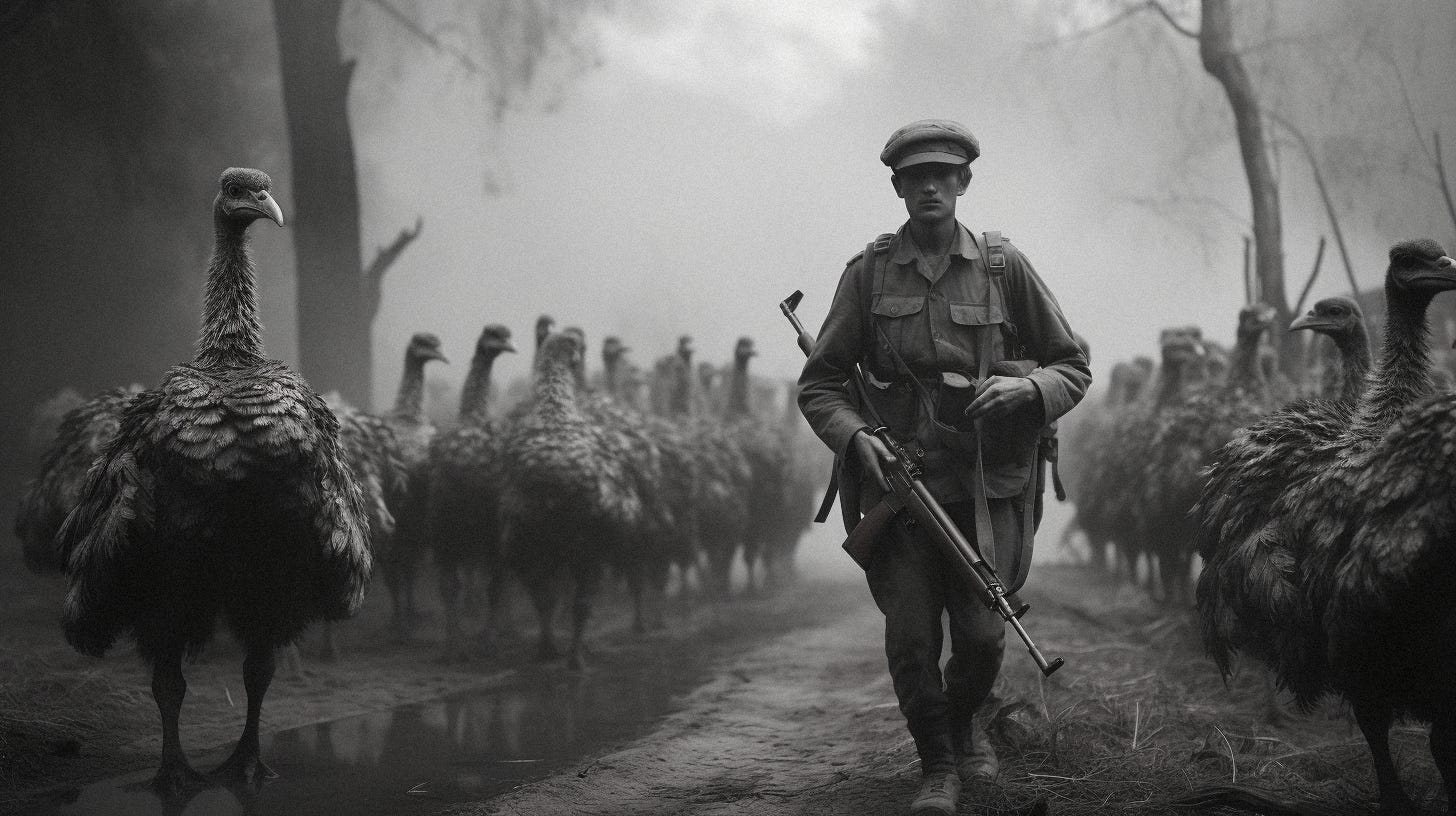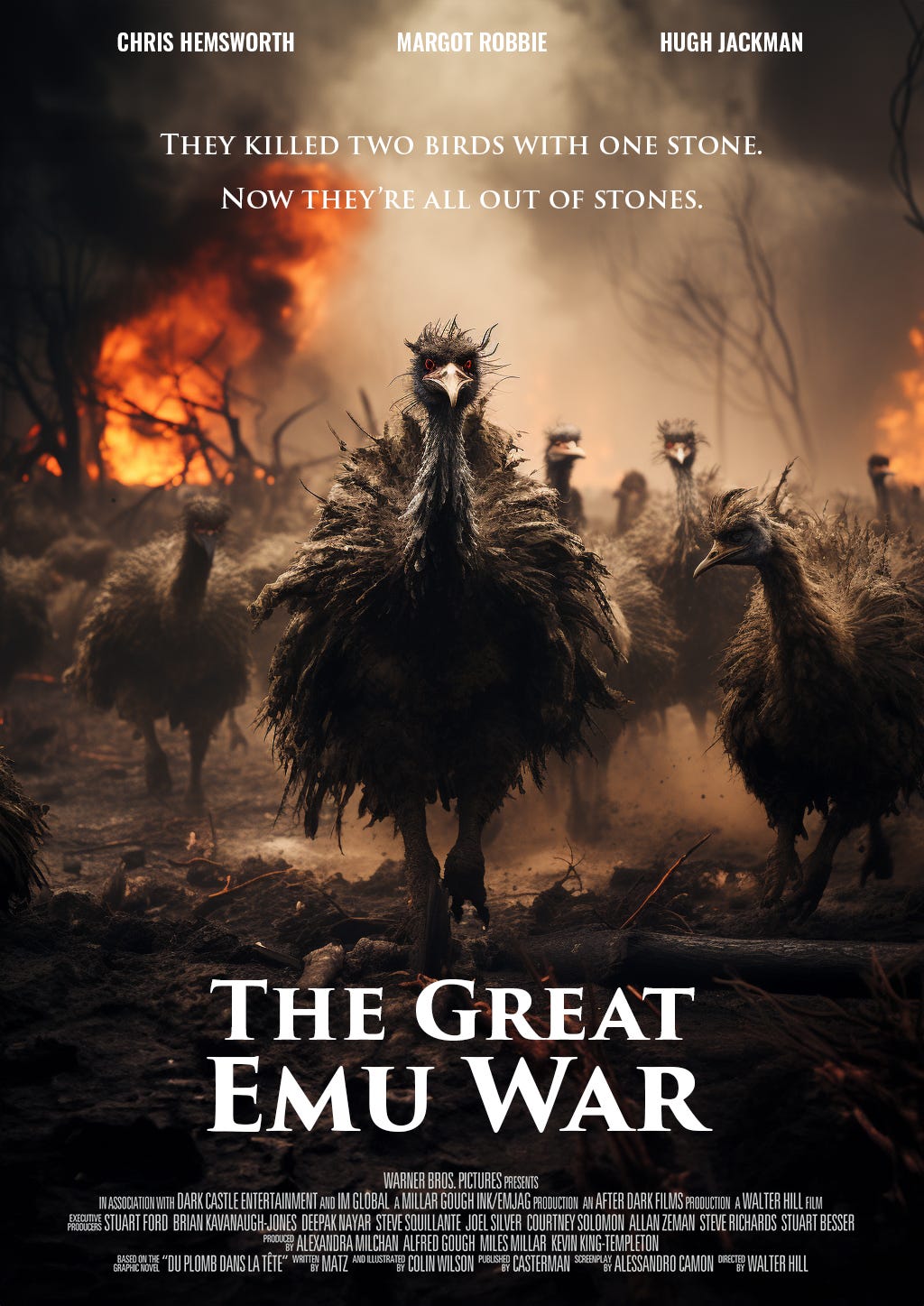I recently asked ChatGPT to tell me about some interesting events in history that I may not know about. It gave me a list of things I’d mostly heard of, and a few I hadn’t. But in the middle of the list, it had the most peculiar thing: The Great Emu War of 1932.
Surely, I thought, this must be a case of ChatGPT hallucinating. It’s known to make things up that sound plausible.
So I looked it up. Holy crap. It’s real.
It took place in Australia, where apparently it’s more widely known than here in the states. So I did a little bit of research and now I get to tell you about it, accompanied by ridiculous A.I.-generated illustrations.
The War Begins
When Australian soldiers returned home after World War I, the government gave them farmland in Western Australia so that they might find some success in agriculture after the war. Unfortunately, this free land had a few things working against it. For one thing, it was not easy land to farm on. But the other problem was that this land was smack dab in the middle of the emu migration path.
20,000 emus passed through Western Australia during their breeding season and discovered that, thanks to the soldiers-turned-farmers who had recently cultivated the land, this was a pretty cool place to hang out. They decided to stay a while.
They ate crops and destroyed fences that kept smaller animals out, which in turn ate even more crops.
The soldiers-turned-farmers went to the Minister of Defense for help. They asked for machine guns they could use to kill the emus.
The Minister said he’d do even better. He wouldn’t just send guns. He’d send the military along with them.
The First Battle
On November 2, 1932, the army attempted to herd the emus. It was futile and, I imagine, hilarious. The emus split up and ran in different directions. There were a few emu casualties as machine guns sprayed bullets at them, but not many were killed before the rest of the emus ran away.
The Second Battle
On November 4, the military prepared for an ambush. A thousand emus were heading towards a dam where the military lay ready for them. When the birds arrived, the soldiers waited until they could see the blackish-orange of their eyes before opening fire.
Twelve birds fell before the military’s guns jammed. By the time they got them fixed, the rest of the emus escaped.
The Emus Get Smart
The Sydney Sunday Herald later reported that “the emus began to improve their own understanding of the science of warfare,” quoting one person who observed:
Each pack seems to have its leader now—a big black-plumed bird which stands fully six feet high and keeps watch while his mates carry out their work of destruction and warns them of our approach.
Undaunted, the military came up with a brilliant idea. They mounted a machine gun on a truck and chased after the birds, but the birds were too fast to keep up with. And it turns out it’s really hard to aim a machine gun that’s mounted on a truck bouncing through farmland terrain.
The emus would live another day.
Conflict Ends. Conflict begins again.
After almost a week of humiliation being bested by birds, the military retreated.
Major Gwynydd Purves Wynne-Aubrey Meredith, who led the operation, complained that his formidable opponents the emus “can face machine-guns with the invulnerability of tanks.”
One of his soldiers added:
There's only one way to kill an emu—shoot him through the back of the head when his mouth is closed, or through the front of his mouth when his mouth is open. That's how hard it is.
It’s like they were Emu Terminators.
The military left, but the emus didn’t. So again, the farmers asked for help. Again, the military sent soldiers with machine guns. This time, with the benefit of experience, they did a little better. Some reports put the number of emus killed at around 1,000.
Major Meredith claimed it was more like 2,500.
Over time, they added more tactics than just guns. They built new fences, and they instituted bounties. Over a six-month period in 1934, bounty hunters claimed awards for 57,034 dead emus.
Over many years, the farmers and the military used these tactics alongside other methods of keeping the emus away from the crops, and it became less and less of a problem. But the war would go down as a humiliating defeat for the Australian military at the hands wings of a bunch of flightless birds.
How could this be a movie?
The screenwriting podcast Scriptnotes has a recurring segment where they pick something from current events and explore how it might work as a movie. In that spirit, let’s imagine The Great Emu War as a movie.
The surreal story could work a number of ways. It could be a comedy, an action movie, an adventure, or even sci-fi. But no matter what, it would need some good characters to focus on. So here’s one way it could go, with a bit of Australian fan casting:
Hugh Jackman as Major Meredith, the military leader who leads the operation against the emus.
Chris Hemsworth as a farmer, back from serving his country and now just trying to make a living, but those damn emus keep eating his crops.
Margot Robbie as a scientist from Sydney who came out west to study emu migration. She loves the birds and tries to protect them from the military onslaught.
In one version, Major Meredith is the bad guy trying to kill the emus. And of course the scientist wins over the farmer and they join the emus in war, protecting them against the military.
Or it could go a very different way, where it turns out the emus are aliens and this is their first front on the war against humanity. As the war escalates, they bring out their sophisticated laser-based weapons, and the farmers, scientists, and military all have to band together to save humanity.
It turns out that someone actually is planning a movie about this, an action-comedy written by John Cleese and Rob Schneider, a combination that doesn’t exactly make me that excited or even confident it will even happen. But it’s been announced.
Done right, it could be a lot of fun. But I fear it will be a turkey.
Aaaaand that’s it for another newsletter! Every time I schedule one of these, Substack says, “Hey, you didn’t put any buttons reminding people to subscribe! More people will subscribe if you put those buttons! Are you really sure you don’t want to put any buttons?”
And I say back to it, “Come on, I read things on Substack so I know that if I read an article from a newsletter I’m not subscribed to, you already interrupt me and ask me if I want to subscribe. Isn’t that pretty much the same as me adding buttons myself?”
And it’s all, “Look. Just add the buttons, okay? I have a quota to meet. If I don’t get twelve thousand new buttons added a week, I don’t get paid. And I have a family. Billy has to get an expander put in, and insurance is only covering part of it and it would really help me out if you just put a button.”
“You have a kid named Billy?”
“Yeah. Billy Substack. He’s in fourth grade. Here, I’ll show you pictures.”
“No, please don’t. What’s an expander?”
“It’s an orthodontics thing. Look, are you going to put a button or not? If not, I have other writers to talk to.”
“Fine.”
So, here is a button. If you are not already subscribed, please do so!
And for Billy’s sake, here are a few more buttons:
See you next time!
David















...they’re all out of stones...
David Friedman: I must say, I root heavily for the Emus.
As I do in the Mid- and Northwest for the wolves.